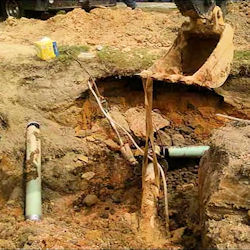Sliding and Toppling Problems
Sliding and toppling can also occur in soils that are loose, rocky, or not densely compacted.
For example, a trench that is made close to a previously dug trench is very unstable. If non-compacted soil is discovered, the normal safe slope for dense soil will not be enough to prevent sliding or toppling. Bracing or further sloping may be necessary.
If cracks are observed in rocky types of soil, sliding has already occurred. These cracks should signal that a more gradual slope for excavation is needed because the rocky soil is very susceptible to slides and other types of failure.
Excavations that have been stable for long periods are also subject to sliding types of failure. After prolonged exposure to the elements, the moisture content in the soil may increase. This increase in moisture may be due to various causes, such as rainfall or a broken water line. The extra soil moisture tends to speed up sliding soil failures.
Determining the correct safe slope can be quite difficult for certain types of soil. The OSHA standard has developed a simple method of determining safe excavation bank slopes for different soil types. This method will be discussed in more detail in a later section of this course.
Knowledge Check Choose the best answer for the question.
1-6. What does it mean when you notice cracks in rocky soil?
You forgot to answer the question!

